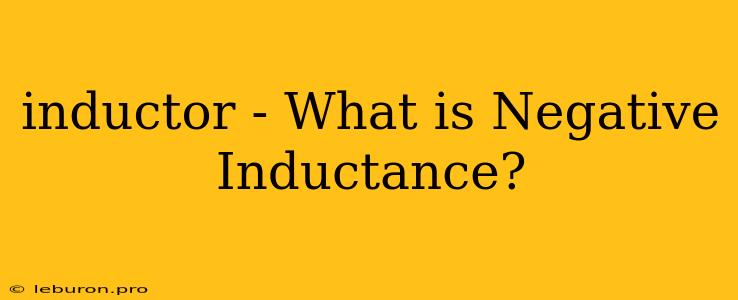Negative inductance is a fascinating concept that challenges our traditional understanding of inductors. While inductors are typically known for their ability to store energy in a magnetic field and oppose changes in current, negative inductance implies a device that behaves in the opposite way. This seemingly counterintuitive phenomenon opens up exciting possibilities in circuit design, particularly in areas like high-frequency applications and active circuit elements. This article delves into the nature of negative inductance, exploring its origins, applications, and how it can be implemented.
Understanding Inductance
Before venturing into the realm of negative inductance, let's establish a firm grasp of traditional inductance. Inductors are passive components characterized by their ability to resist changes in current flow. When current flows through an inductor, a magnetic field is generated around it. This magnetic field stores energy and opposes any change in the current. The strength of this opposition is measured by the inductance, typically denoted by the letter 'L' and measured in Henrys (H).
Lenz's Law and Inductance
Lenz's law, a fundamental principle of electromagnetism, explains the inherent opposition to current changes in inductors. It states that the induced electromotive force (EMF) in a circuit opposes the change in current that caused it. This opposition manifests as a back EMF that acts against the applied voltage, effectively slowing down the current change.
The Mystery of Negative Inductance
The concept of negative inductance flips this behavior on its head. Instead of opposing changes in current, a negative inductance encourages them. In essence, a negative inductor acts like a "negative" energy storage device, providing energy to amplify current fluctuations. This seemingly paradoxical behavior raises questions: how can energy be stored in a "negative" way, and what implications does it have for circuit design?
The Key to Negative Inductance
The key to understanding negative inductance lies in recognizing that it's not an inherent property of a physical component like a coil of wire. Instead, negative inductance is achieved through active circuits that emulate the behavior of a negative inductor. These circuits typically involve:
- Active devices: Transistors, operational amplifiers, or other active components play a crucial role in generating the desired negative inductance.
- Feedback mechanisms: Negative feedback loops are employed to control the active devices and create the desired current-enhancing effect.
- Capacitance and resistance: These passive components are often used in conjunction with the active elements to fine-tune the negative inductance characteristics.
Applications of Negative Inductance
While traditional inductors are ubiquitous in electronics, negative inductance finds its niche in specific applications where its unique properties offer advantages:
1. High-Frequency Applications
Negative inductance can be particularly beneficial in high-frequency circuits. At these frequencies, traditional inductors become less effective due to parasitic effects like resistance and capacitance. Negative inductance can counteract these limitations by providing an effective inductance even at frequencies where traditional inductors struggle.
2. Active Circuit Elements
Negative inductance opens the door to designing active circuit elements with unique properties. By incorporating negative inductance, engineers can create circuits that perform tasks traditionally achieved with multiple passive components, potentially reducing complexity and improving efficiency.
3. Metamaterials
Metamaterials, engineered materials with properties not found in nature, often rely on negative inductance for their functionality. These materials exhibit unusual electromagnetic properties, such as negative refractive index, leading to applications like cloaking devices and super-resolution lenses.
Implementing Negative Inductance
While the concept of negative inductance may seem abstract, its implementation is based on practical circuit design techniques:
1. Gyrator Circuits
A gyrator circuit is a common approach to creating negative inductance. It utilizes an active device, like an operational amplifier, and feedback mechanisms to simulate the behavior of a negative inductor. By strategically configuring the gyrator, the circuit can exhibit a negative inductance value.
2. Active LC Tank Circuits
Active LC tank circuits can also achieve negative inductance. These circuits involve an active device, typically a transistor, along with a capacitor and a resistor. By carefully adjusting the feedback loop, the circuit can generate negative inductance for specific frequencies.
The Future of Negative Inductance
Negative inductance is a rapidly evolving field with immense potential. As research progresses, we can expect to see:
- Improved implementations: Ongoing research focuses on developing more efficient and compact implementations of negative inductance circuits.
- Novel applications: Negative inductance is likely to find its way into new and exciting applications across diverse fields, from communications to energy harvesting.
- Integration with other technologies: The combination of negative inductance with other emerging technologies, like metamaterials and nanomaterials, promises to unlock unprecedented possibilities.
In conclusion, negative inductance is a testament to the ingenuity and adaptability of electrical engineering. While seemingly contradictory to traditional inductance, it offers unique properties with vast potential. As our understanding of negative inductance deepens, we can expect to see its impact expand across various technological frontiers.
